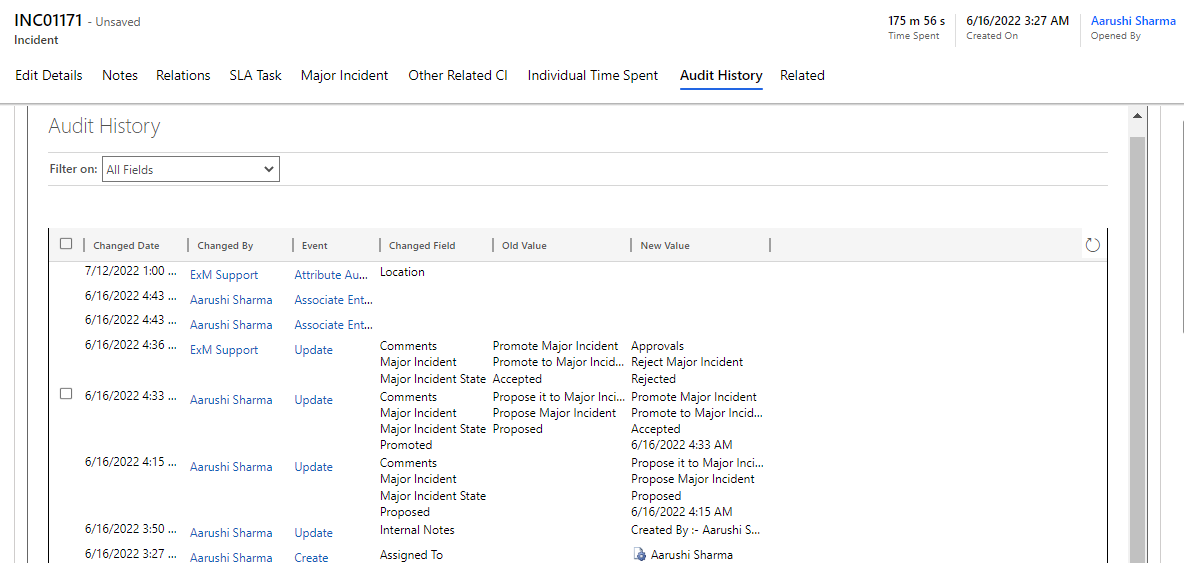Incident Form
Edit Details tab
All the information related to the Incident is present in this tab. An Admin can view/edit the fields and update the incident.
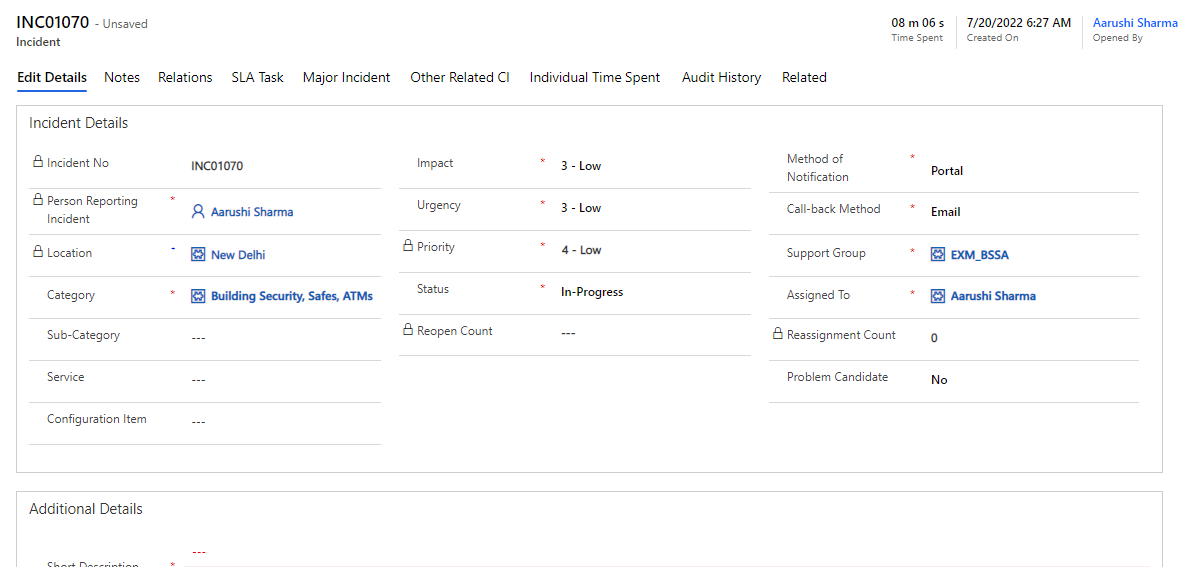
| Fields | Description |
|---|---|
| Assigned To | User who works on the incident. |
| Call-back method | Communication method used by the fulfiller to contact the user. |
| Category | Type of issue. |
| Closure Category | A category needs to be selected to resolve the incident. |
| Closure Notes | The notes will be added once the incident is resolved. |
**Configuration Item** | Affected CI, if applicable. |
| Created On | Capture the date and time of incident registration. |
| Description | Detailed explanation on the incident. |
| Documents Section | Add/View all the attachments related to Incident. |
| External ID | Unique Record Identifier for external systems. |
**External System** | External System associated with the incident. |
| Impact | Impact is a measure of the effect. |
| Incident Number | Unique auto-generated incident number. |
| Informed Names | Users who receive update notifications about this incident. |
| Location | Location of the person reporting incident. |
| Method of Notification | Communication method used by the user to create incidents. |
| On-Hold Reason | A reason needs to be filled once the incident status is on-hold. |
**Person Reporting Incident** | User who contacted you with an issue. |
| Priority | Priority is based on impact and urgency. The Priority Matrix is configurable and can be accessed from the Administration section of the application. Administration > Priority Matrix Priority Matrix The EXM platform requires us to provide justification for manually overriding priority. |
| Problem Candidate | The default is set to No. |
**Reassignment Count** | Number of times the Support Group has changed. Reassignment Threshold: After a specific count of Reassignment, an email/Teams notification will be sent out to a group that can be configured from System properties, with the Incident details captured. |
| Reopen Count | Number of times user reopens the incident. |
| Resolved Date | The date for Resolving is captured automatically. |
| Service | Indicates the services tied with the incident based on Category and Sub-Category. |
| Short Description | Brief description of the incident. |
| Status | Status of the Incident. Out of box choices are: · New · In-Progress · Resolved · Closed · Canceled · On-Hold |
| Sub-Category | On Selecting Category, Select the Subcategory, if applicable. |
| Support Group | Group who will work on the incident. |
**Time Spent** | Time spent on the incident. |
| Urgency | Urgency is a measure of how long the resolution can be delayed. |
Incident Task
An incident task is used when a particular incident requires other support groups to get involved in order to resolve one incident. Incident tasks are child of incidents. If you want different teams to perform tasks as part of the incident, you can create an incident task under the incident and assign it to that team.

Notes tab
Internal Notes
Admin can add internal notes by clicking on the
button on the top ribbon. Special instructions or information is recorded herein on how to resolve, or steps taken to resolve the incident, if applicable. Any internal notes are not visible to the customer.
A popup appears where one can add an internal note.
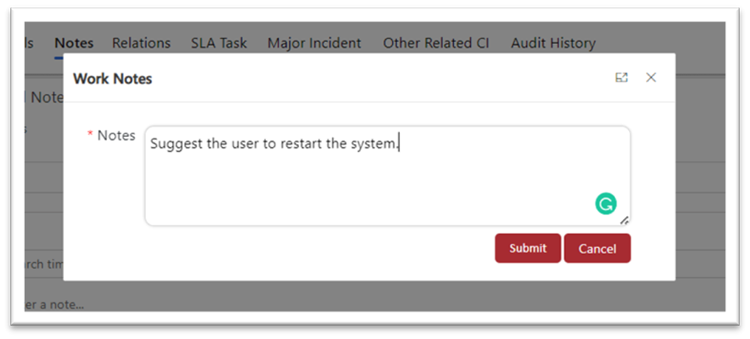
Click on the Submit button to add the note.

Timeline
The Timeline maintains a historical record referencing when a ticket is updated, or if any notes are added. Also, one can add attachments to the notes.

Relations tab
All the related records for the incident can be found in this tab.
Change Request
To add an already created change record to the incident, click on the Change Request field and add the Change Record.
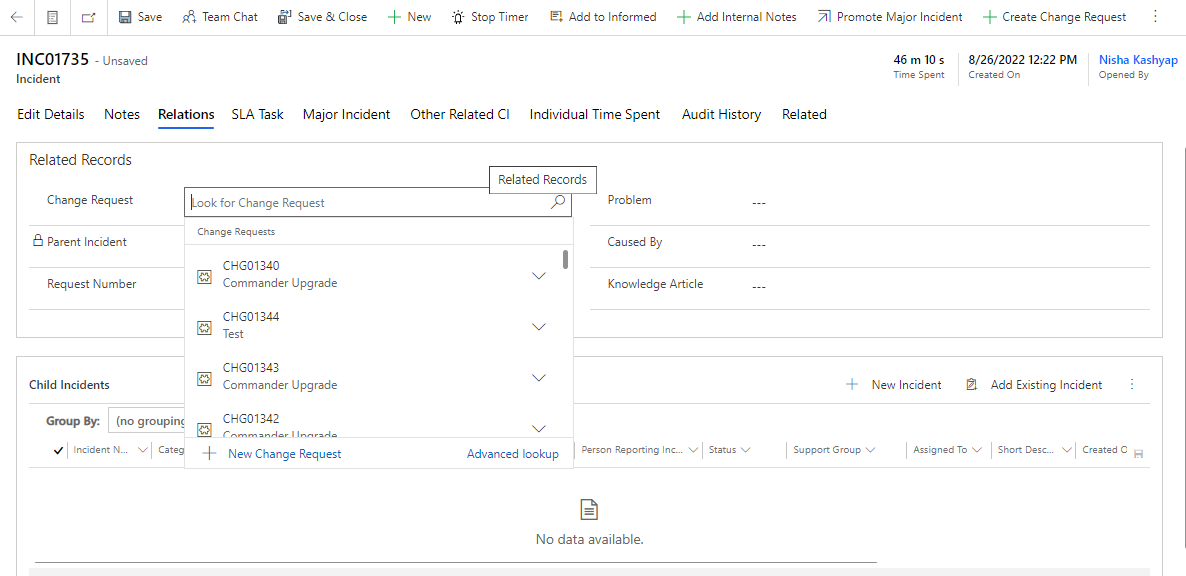
To add a new Change record, click on the button on the top ribbon. You will be redirected to Change Request Module.
Related Problem
To add a previously created problem record to the incident, click on the Problem field and select the Problem Record.
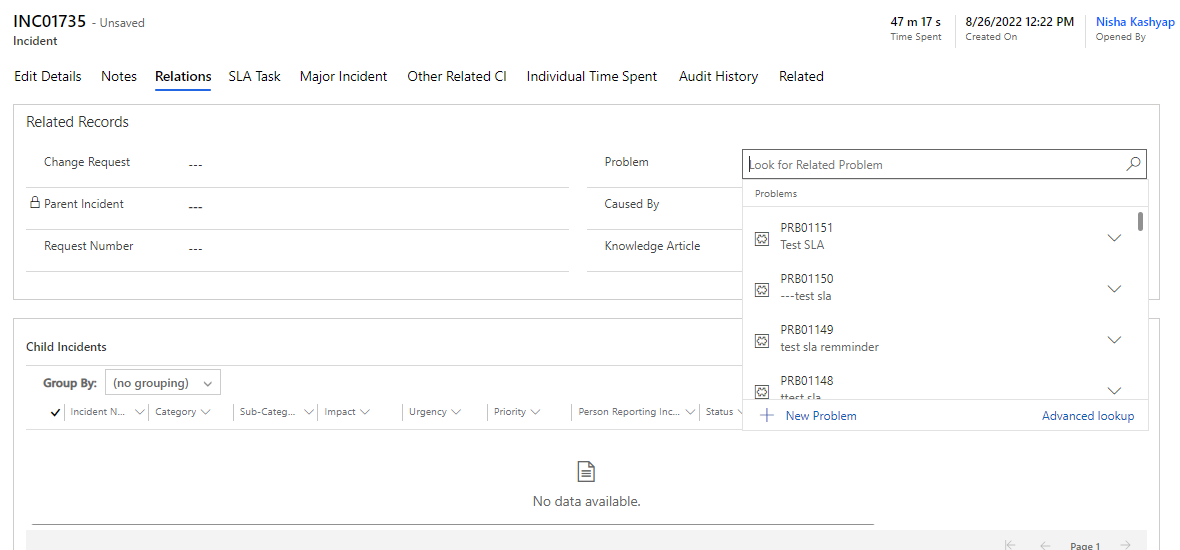
To add a new Problem record, click on the button on the top ribbon. You will be redirected to the Problem Module.
Caused By
Is a relationship between Incident Record(s) and associated RFCs. To add a record in this field, click on the field and select the related record.
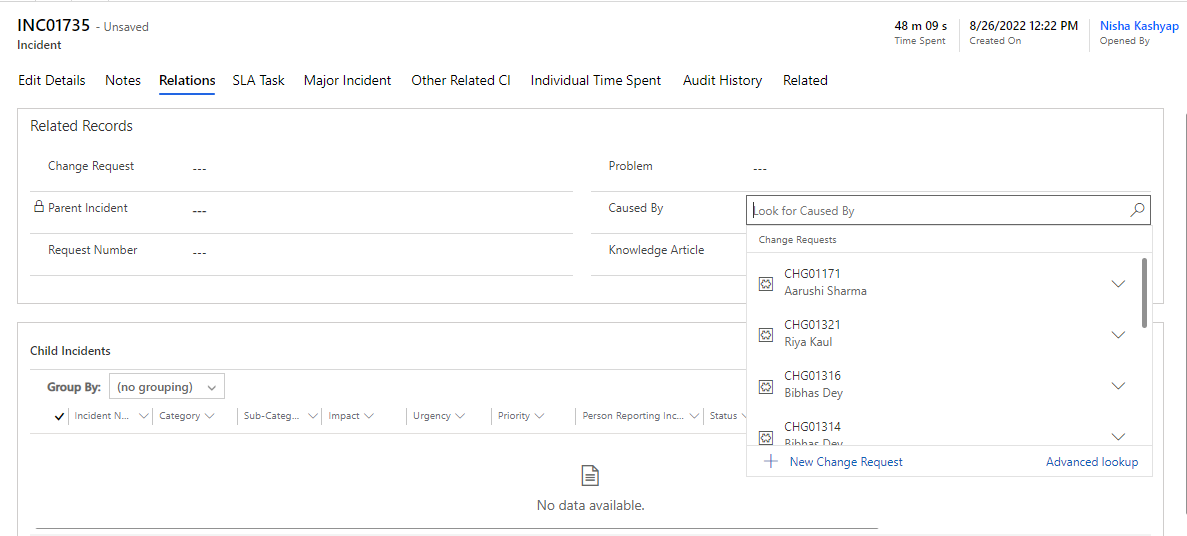
Parent Incident
Unique number which links the current incident to a parent incident.
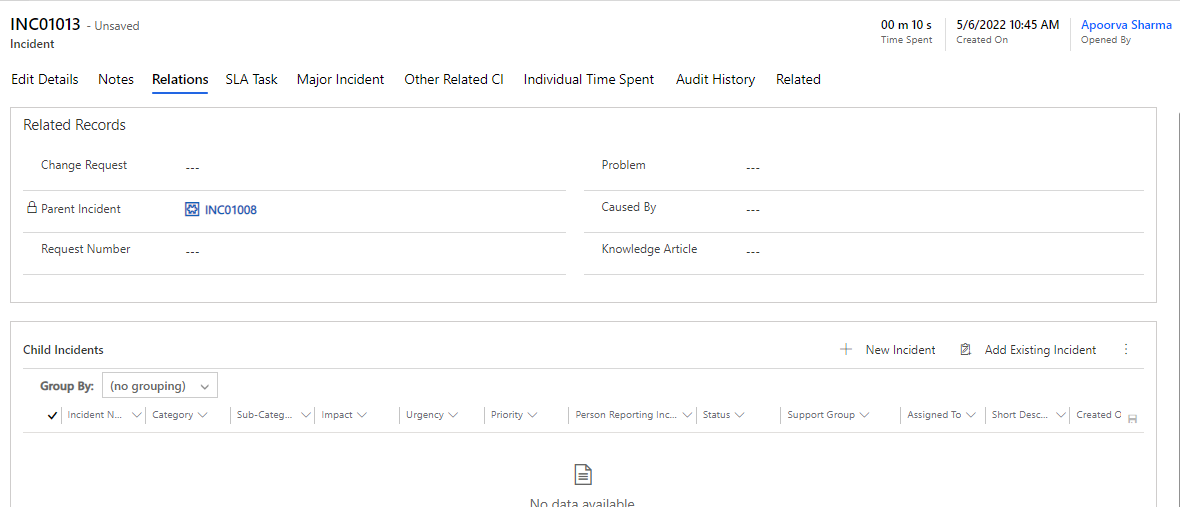
Child Incident
An admin can add child incidents via the Child Incident section and afterwards a record will link to a parent incident automatically.
There are two ways to associate a child incident to a parent. The first is to click on the “New Incident Details” button and the second is to click on the “add existing incidents details” button, either method associates a children incident to the current incident record.

Knowledge Article
The EXM platform integrates with Knowledge Management to support the incident investigation, diagnosis, and resolution. Once the incident is resolved, the Knowledge Fulfiller can create a knowledge article out of the incident by clicking on
button in the top ribbon.
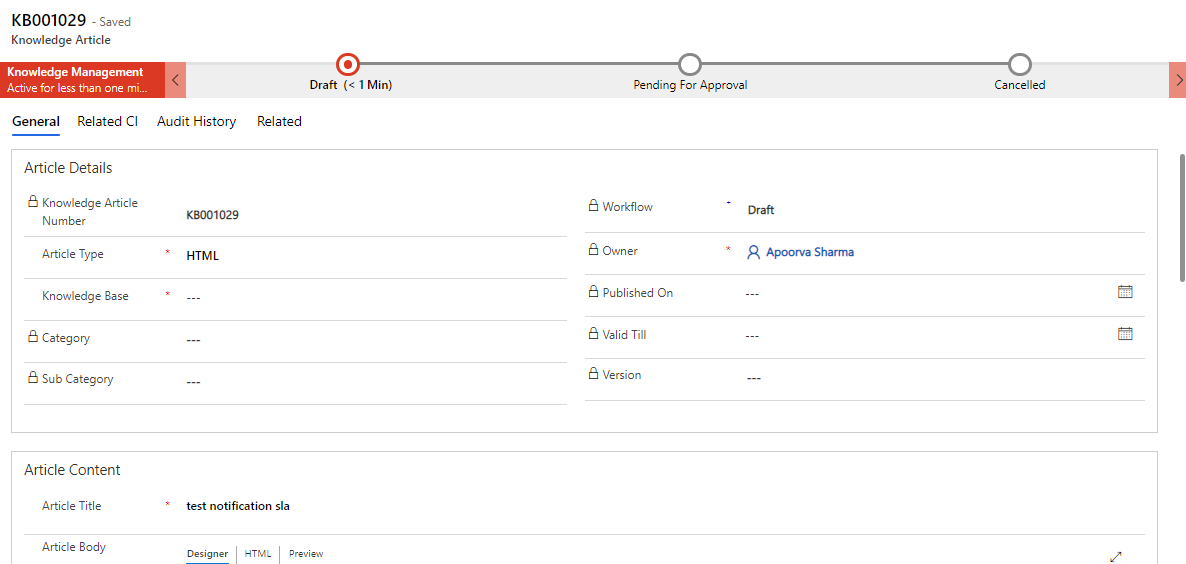
Request Number
The EXM platform integrates with Request Fulfillment to enable rapid opening of a Service Request Record from an Incident Record; and to establish a linked relationships between the Incident Record(s) and associated Service Request Record(s).
SLA Task tab
SLA (Service level Agreement)
A service-level agreement (SLA) is a commitment between a service provider and a client. Fundamental aspects of the service are quality, availability and responsibilities that are agreed upon between the service provider and the service user. You can create one or more Service Level Agreement (SLA) definitions and use them to create an SLA record. The SLA record provides a method to establish an SLA that are meaningful for your organization's requirements.
Create an SLA Master Record
- Navigate to SLA Master section. Administration > SLA Master.
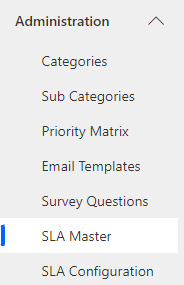
SLA Master Section
- Click New. The SLA Master form is displayed.
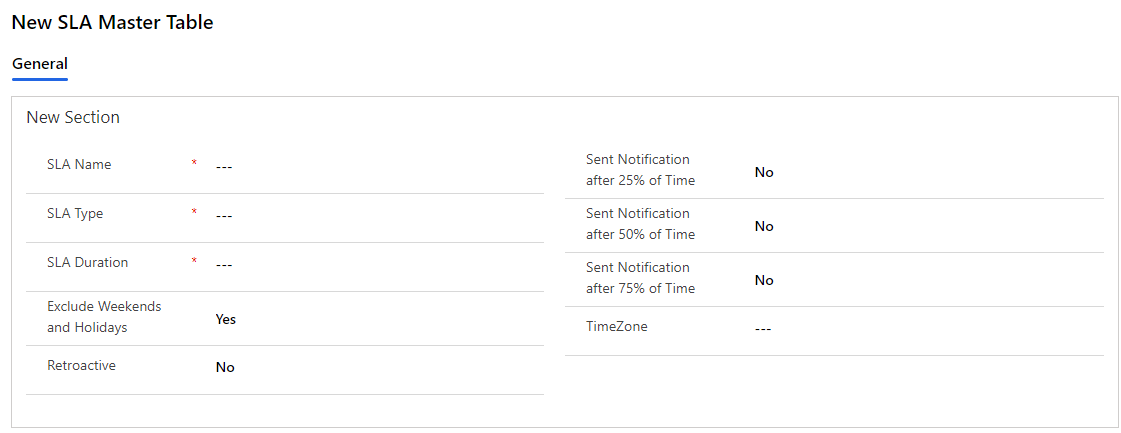
SLA Master Form
- On the form, fill in the fields.
| Field | Description |
|---|---|
| SLA Name | Name that identifies the SLA |
| SLA Type Select the type | Response or Resolution |
| SLA Duration | Specify the length of time in hours |
| Exclude Weekends and Holidays | Whether to include or exclude holidays. Specify Yes or No |
| Retroactive | Specify the SLA Start time: If Retroactive is “Yes” then |
| Send Notification after 25% of Time Specify to send the Notification at 25% of SLA Duration: | Yes or No |
| Send Notification after 50% of Time Specify to send the Notification at 50% of SLA Duration: | Yes or No |
| Send Notification after 75% of Time Specify to send the Notification at 75% of SLA Duration: | Yes or No |
| Time Zone | Specify the Time Zone |
Add a Company Holiday Record
- Navigate to Holiday List Table. Foundation Data > Holiday List.
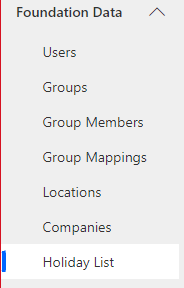
- Click New. The Company Holiday form is displayed.

Holiday List Form
- On the form, fill in the fields.
- Based on the user Time Zone the holiday will be added in the SLA.
Create an SLA Incident Configurations Record
The table defines automatic assignment based upon an Incident’s priority, subcategory, and category values.
- Navigate to SLA Configurations Tables. Administration > SLA Configuration.
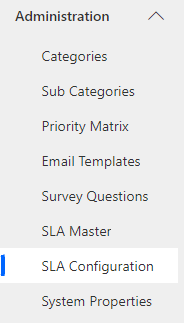
- Click New. The SLA Configurations form is displayed.
- On the form, fill in the fields.

SLA Configuration Form
| Field | Description |
|---|---|
| SLA Name | Specify the SLA name that links to “SLA Master” table associated with the same name |
| Priority | Specify the Priority |
| Category | Specify the Category |
| Subcategory | Specify the Sub-Category |
| Module | Specify the name of the Table |
SLA Process Example:
This example demonstrates how an SLA can be associated to an incident:
- Navigate to Incident Details section.

Incident Form
- Fill Category, Sub-Category, and Priority.
- Save the form.

SLA Task Tab
If we change any field from the Priority, Sub-Category or Category in Incident table, the first SLA will cancel and attach the new SLA based on the fields (Priority, Sub-Category, and Category)

SLA Notifications
Sending Reminder for SLA Breached
When a new incident is created then the system matches the appropriate impact and urgency SLA, and it is then added into the SLA Task entity. Here is an example of the SLA Task entity containing entries.

Then from left navigation go to Administration > SLA Master.
Open that SLA Master table
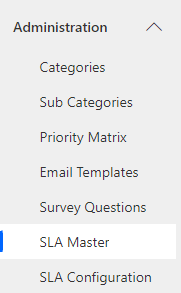
SLA Master Table
Compare the SLA Name and Type that we get in SLA Task entity and compare these two fields with SLA Master Table entity.
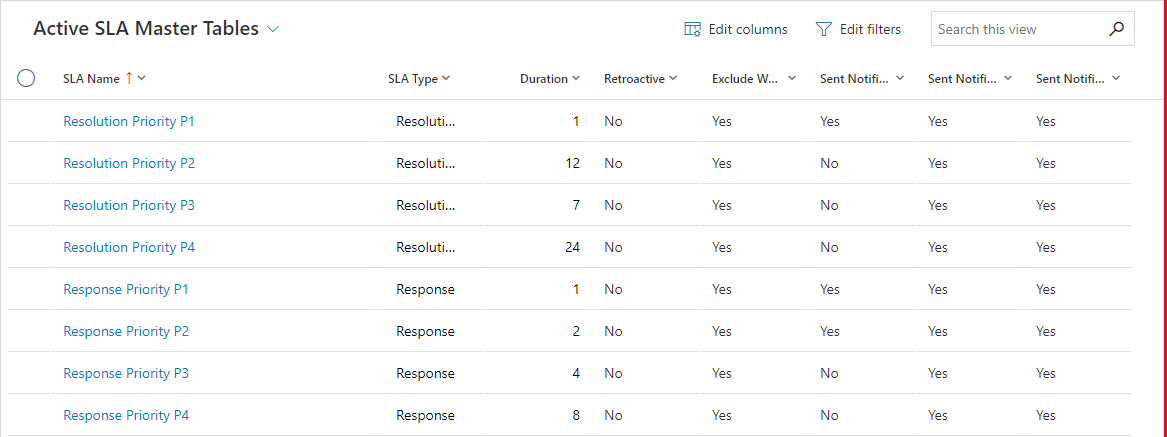
SLA Master List

Where these two fields are equal fetching that record from SLA Master Table and these records look like this:
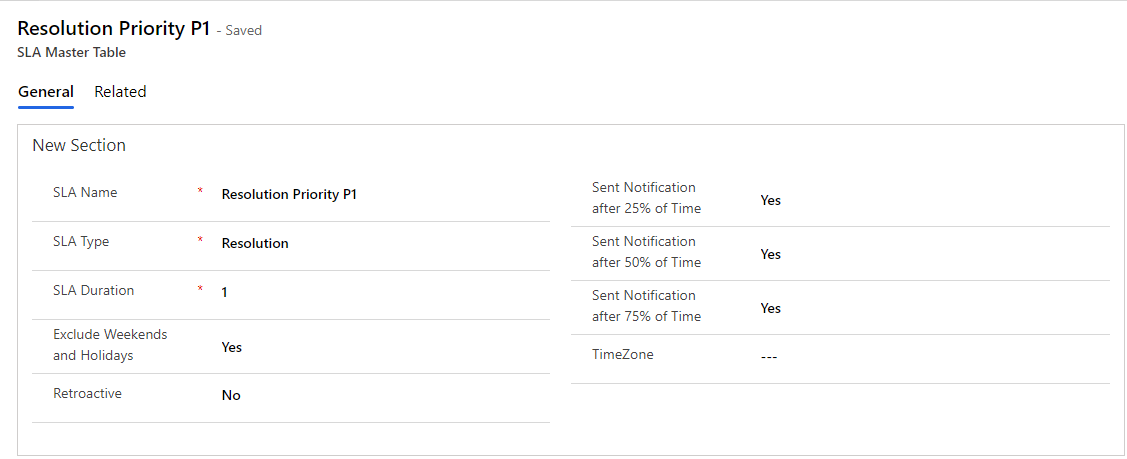
SLA Master Form
Then checking the Field Value Sent Notification after 25% is Yes or No, if it is Yes then calculating the total Time Difference between Sla Start On and Breach Time field

And after that we have total time for that SLA and after that calculate the 25% of that total time and after 25% time is completed then again check for Sla State in SLA Task

If the state is still in progress, then go to that incident from the left navigation and check for currently assigned Support Group or Assigned to person
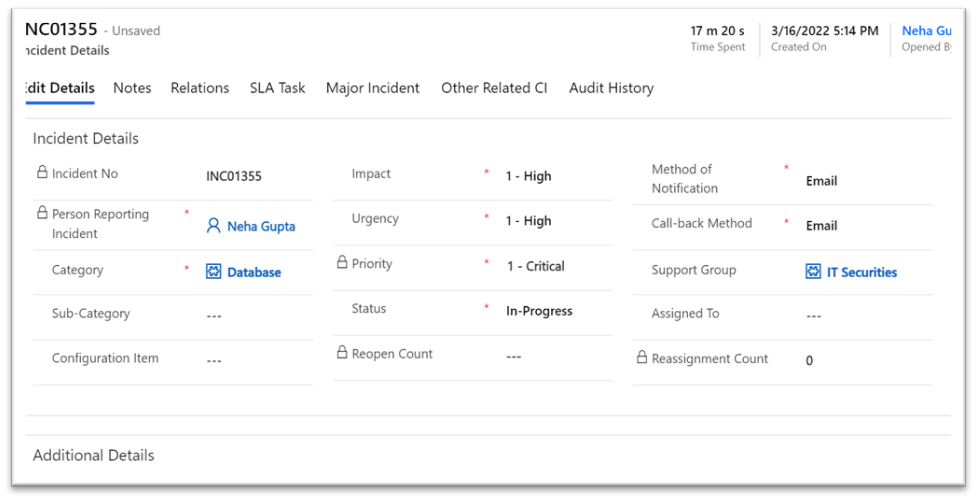
And send Reminder Email to that IT Security Group. If the state is Cancelled or complete Like this
Then Email notification is not sent.

After sending 25% reminder Email again check for SLA State

if it is still in progress then same process is follow for 50% and 75% Reminder Email and for sending Breached SLA Reminder Email aging check for SLA State if it is still in In Progress then send email notification. Then calculate the total time difference between SLA Start On and Breach Time.

Then checking for that SLA if sent Notification value at 25% is true or false If value is true then calculate the 25% of total time and after that calculate the 25% of total time. After the 25% time is gone then check for State of That SLA if the State is still In Progress like this:

Then check for currently Assigned person or support group for that incident from Incident Entity like this:
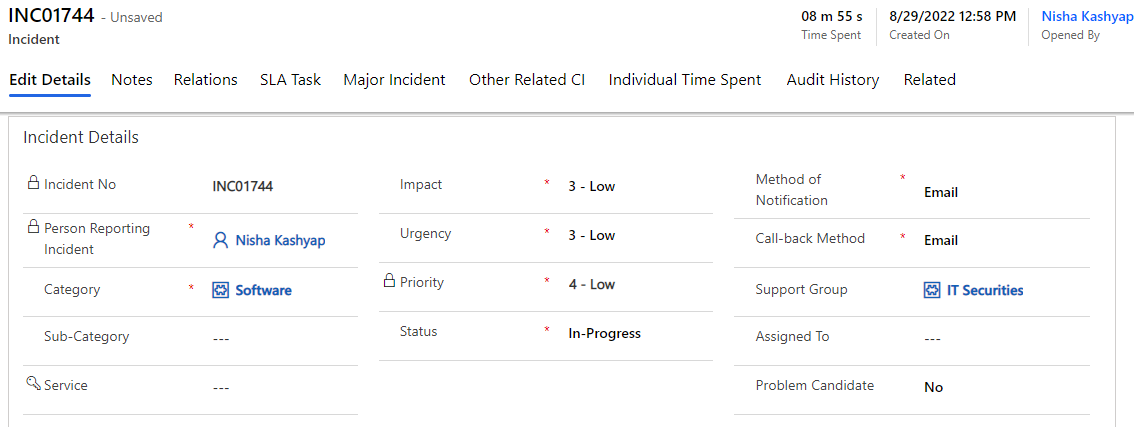
Then send an email notification to the Assigned person or Support group. After sending Email Notification for 25% SLA has Breached again check for SLA State if it is Still in Progress then same process is followed for 50%,75%. For Breached Ticket checking for SLA State is still in Progress then send Email notification to concerned person or group.
Major Incident tab
A major incident (MI) is an incident that results in significant disruption to the business. A major incident demands a response beyond the routine incident management process. Major incidents have a separate procedure with shorter timescales and higher priority, so that there is a faster resolution process for incidents with high business impact.
Propose Major Incident
Propose an incident as a major incident by clicking Propose Major Incident Button on top of the Incident form.
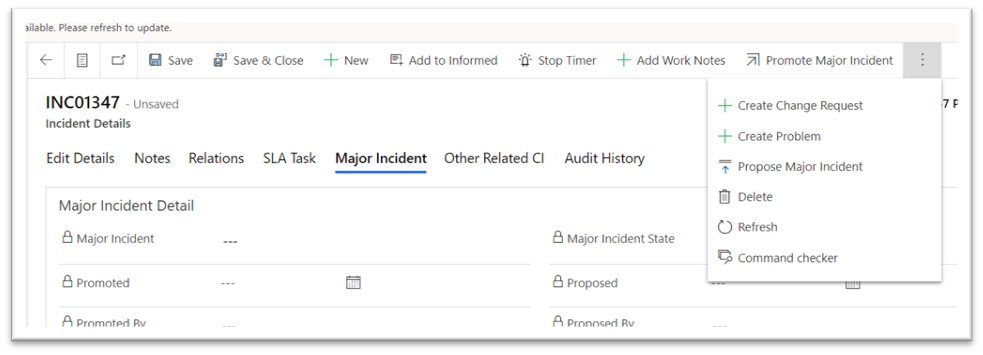
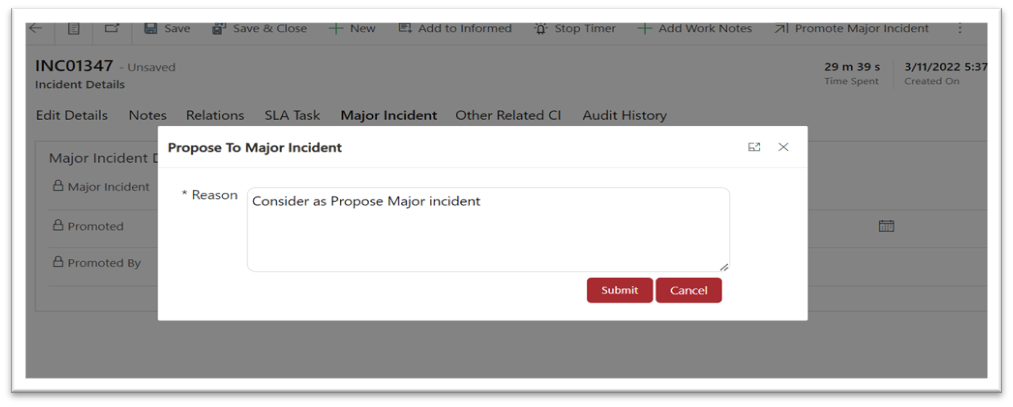
On Proposing a major Incident, an approval is sent to the Major Incident Team to either Promote or Reject the incident.
Major Incident Team can be configured from
Foundation Data > Group Mapping > MajorIncidentApproval.
Add any Support Group that will be notified for Major Incident Approvals.

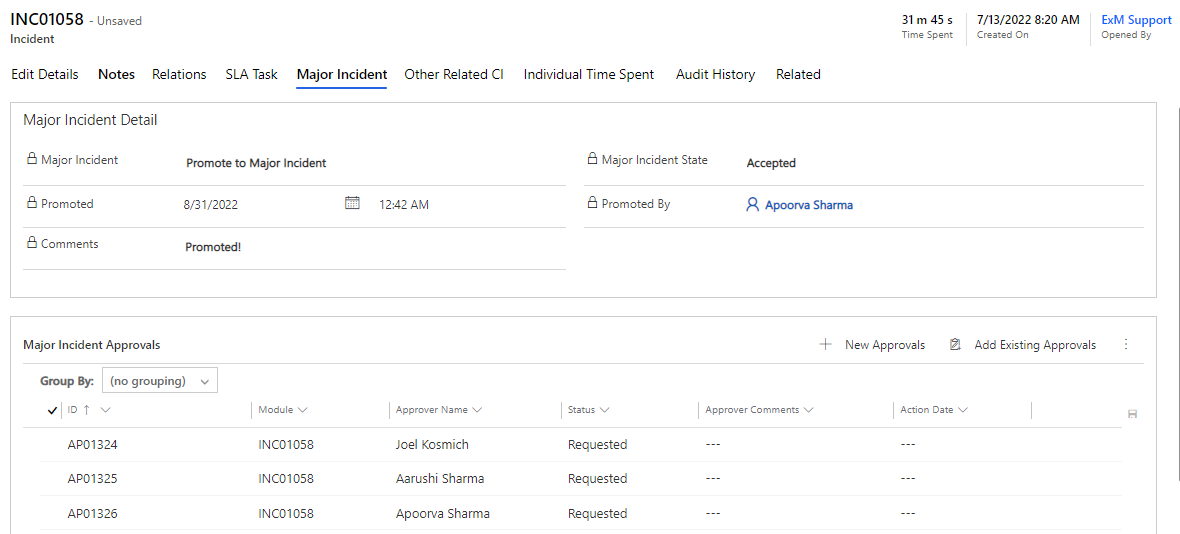
The approval request can be approved/rejected from MS Teams or email notification.
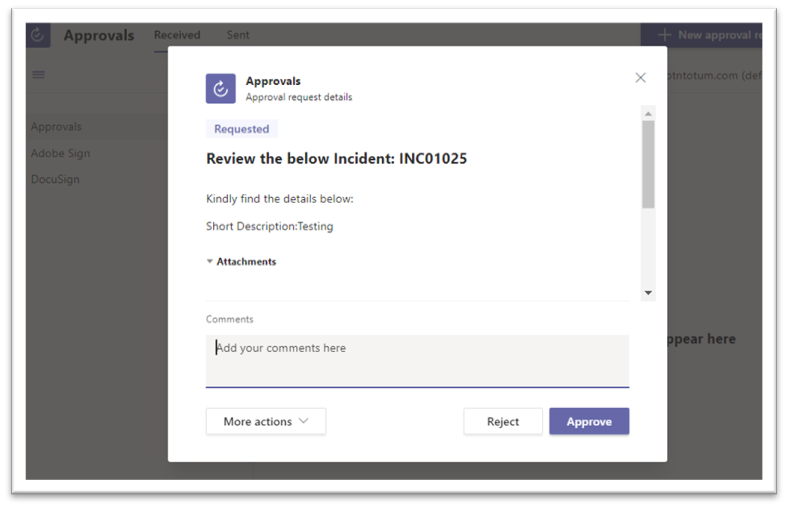
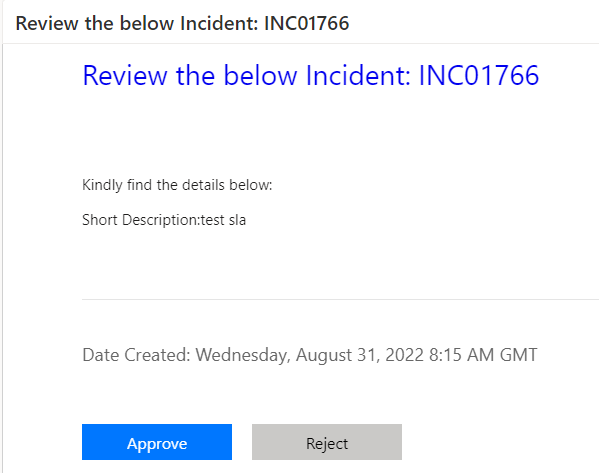
The Incident will be Promoted to Major Incident once the Approval is approved, and the comments are also captured.

If the approval is rejected, the incident will not be considered Major, and the major incident state is updated to Rejected along with the comments of approver.
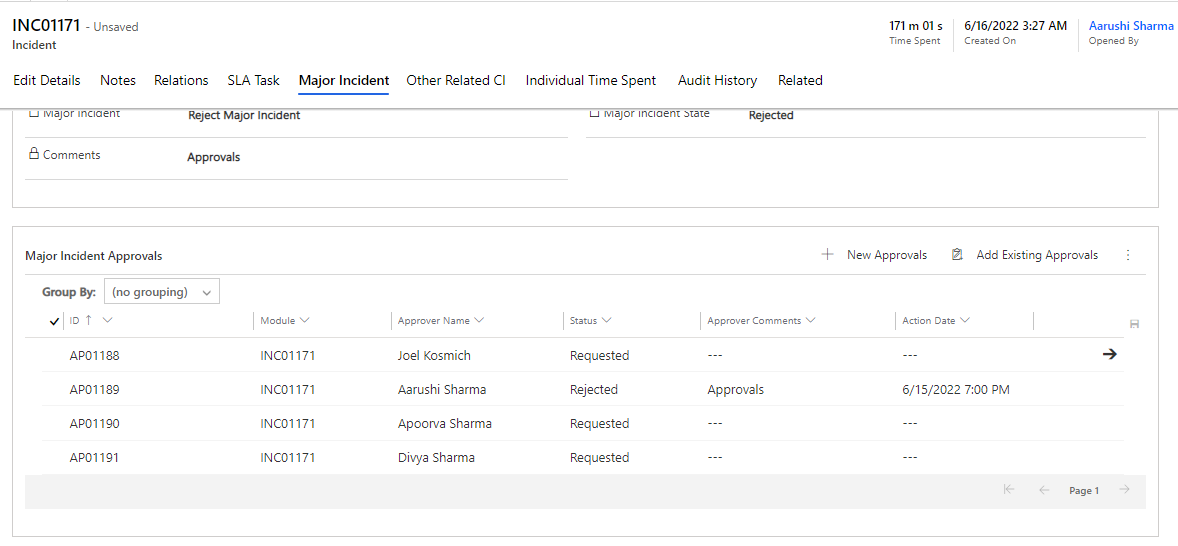
Promote Major Incident
• Create a new major incident by clicking Promote Major Incident on Top.
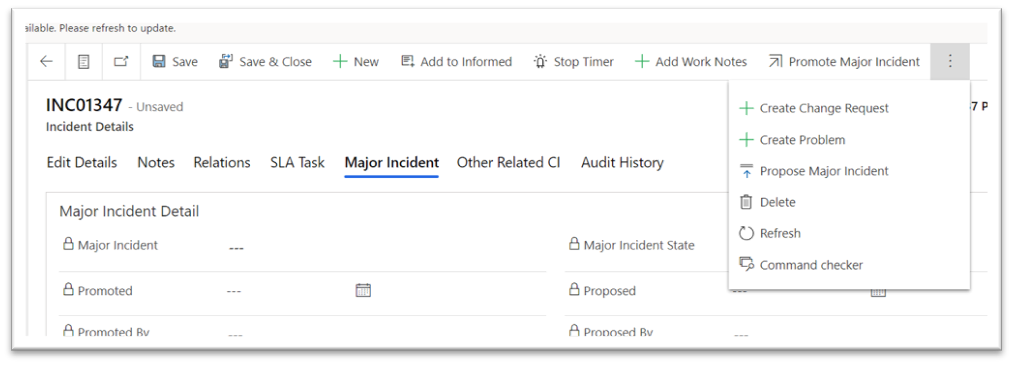
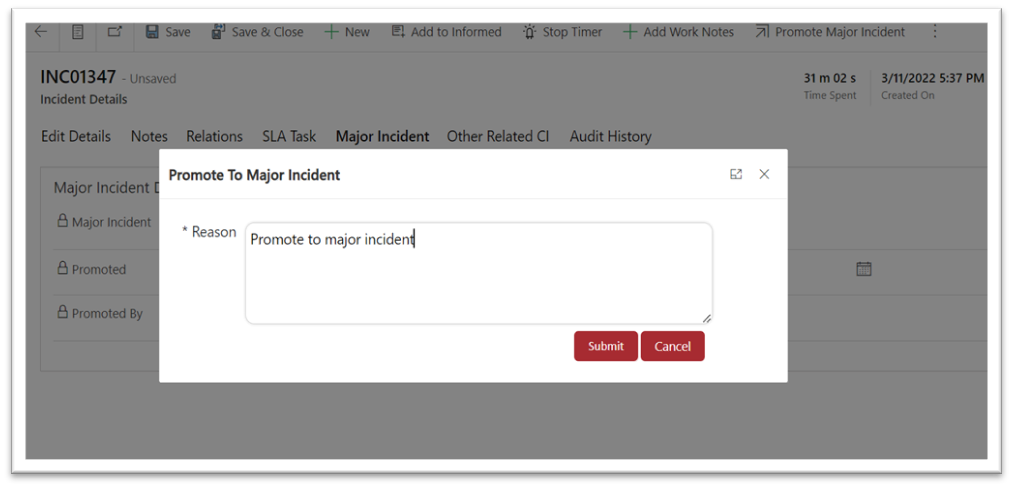
Demote Major Incident
When an incident is incorrectly evaluated to be a major incident, you can demote the major incident.
By Clicking On Demote Major Incident button this Popup will Appear and need to fill the Reason to Reject the Major Incident.
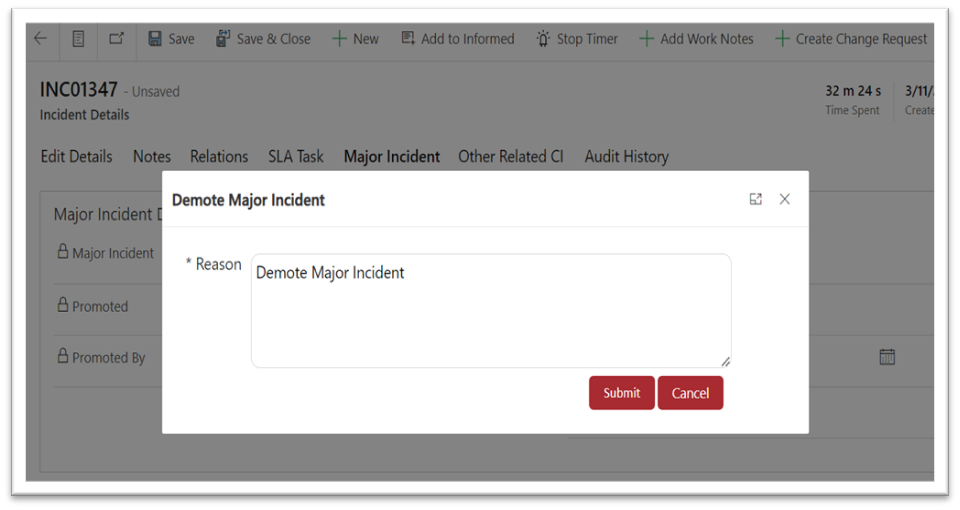
Reject Major Incident
When an incident is proposed as a major incident, a major incident manager can reject the major incident if it is not valid to promote in major incident.
• To reject the incident by clicking Reject Major Incident Button on top.

By Clicking On button this Popup will Appear, and We need to fill the Reason to Reject the Major Incident.
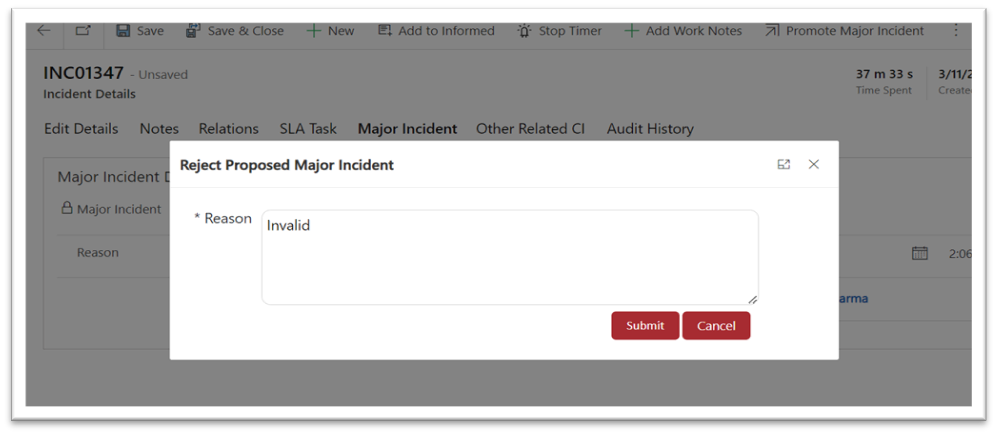
| Fields | Description |
|---|---|
| Major Incident | The state of major incident. a. Propose Major Incident b. Promote to Major Incident c. Reject Major Incident d. Demote Major Incident |
| Major Incident State | The state of major incident. a. Proposed b. Accepted c. Rejected d. Demoted |
| Promote | Date and time when the incident was proposed as a major incident candidate. |
| Promoted by | The user who promoted the incident to a major incident. |
| Proposed | Date and time when the incident was proposed as a major incident candidate. |
| Proposed by | The user who proposed the incident to a major incident. |
| Comments | Comments of the Approver are captured. |
Other Related CI tab
Associate affected or impacted configuration items (CIs) with an incident record to find out how the incident affects other CIs with dependent relationships.
Individual Time Spent tab
Capture the time spent by individual users who worked on the incident.
The total time is calculated by summing up the time spent by all the individual users who worked on the incident so that the business impact is calculated.
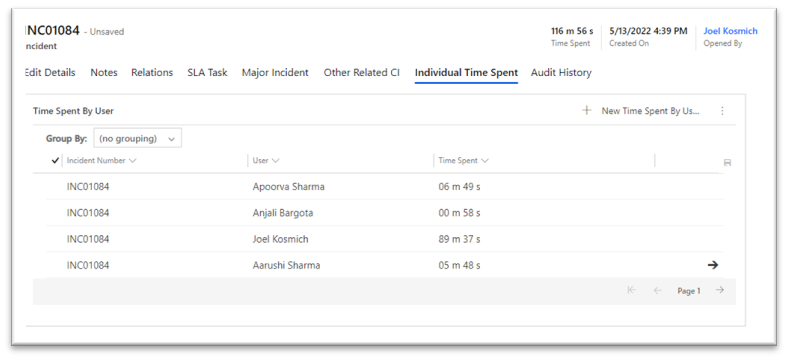
Audit History tab
Any changes/updates made to the incident will be captured in the audit history tab. The person who made the changes will be captured along with the time and the updated fields.
Audit History is where the system stores historical information for all records. These records are intended to be kept forever so that administrators can always track the history of audited records. As the number of auditing records grows over time, it becomes more inefficient to directly query the Audit table for historical information.
